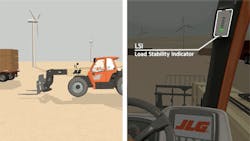Telehandlers are used to lift, carry, and place materials around job sites, but the operator must ensure that the material is within the rated capability of the construction machine for safe operation.
There is no substitute for knowing the weight and center of gravity, but an operator aid from JLG helps the operator stay within the telehandler's longitudinal or forward load capability.
This article was supplied by JLG. Brian Barkley is a senior chief engineer.
Load Stability Indication (LSI) has four primary components. The first is a sensor attached to the rear axle that is able to measure the weight applied to the rear axle of the telehandler. Although the sensor is robust and securely bolted to the rear axle structure, this area must be protected from damage and abuse that might impact or otherwise damage it or its connection to the axle.
The sensor on the rear axle provides the rear axle load measurement to the telehandler control system; the second part of the LSI system. The vehicle control system is the brain of the vehicle, collecting and transmitting data and commands to many parts of the telehandler.
The vehicle control system sends data to the LSI display in the cabin, which is the third part of the LSI system. It is the LSI display that provides the operator a visual indication of the forward stability status of the vehicle.
There are 6 levels of indication in the display, progressing from green (load within capability) to orange (load capability nearing limit) to red (load capability at the limit). If the forward load capability of the telehandler is reached, a red lamp is illuminated on the display. When this happens, an audible alarm is activated, and the vehicle control system will stop and prevent further activation of many of the hydraulic implement functions. This is done to aid in preventing a further decrease in stability of the telehandler. The only implement functions available to the operator to correct the stability of the telehander are retract boom (in) and lift boom (up). When stability has been improved, the audible alarm will turn off and the display will return to orange.
There is the potential for factors or situations in which an operator may choose to continue operating the vehicle with the red lamp illuminated and hydraulic implement functions inhibited. This is possible if the operator depresses the LSI Override Switch; the fourth and final part of the LSI system. This will not deactivate the red lamp or audible alarm, but it will allow prevented hydraulic implement functions to be activated again for up to 30 seconds, or until stability of the vehicle has been improved.
The LSI system must be calibrated and verified periodically. Recalibration of a healthy system is generally only required after service of the system or components related to the system, if the periodic verification check fails, or if the unladen weight distribution of the vehicle has changed since the last calibration.
Differing attachments on the vehicle do not affect the calibration, but things such as wheels and tires with significantly different weights, such as different fill media, may affect the calibration.
The LSI system is always active, not just when the telehanlder is stationary and placing loads. When driving while simultaneously operating the hydraulic implement functions in applications such as aggressive re-handling of material or truck loading, the LSI system may in rare cases momentarily indicate the telehandler is at the stability limit and prevent functions as explained above. The LSI system will allow the telehandler to be operated with the boom retracted without the function cutout or audible alarm activating when the red (LSI) lamp illuminates. This passive LSI mode is indicated by a yellow lamp in the cab.
Lowering the boom from a high angle is a function that may quickly affect forward stability. The LSI system considers multiple factors for each boom lower request from the operator and determines how best to react to the request. Depending on stability level, boom extension, boom angle, and level of activation requested, the telehandler control system determines the appropriate acceleration and speed at which to execute the boom lower request. The operator still has full control to stop the action at any moment, but the control system will determine the appropriate deceleration to terminate the boom lower request.
Even with these controls in place, there may be some situations where the boom is being lowered and the stability limit is quickly reached. The red LSI lamp, audible alarm, and boom lower function cutout may activate momentarily and then deactivate. This is due to vehicle dynamics and the boom lower function can simply be returned to neutral, then carefully reengaged to continue the lower boom function.
